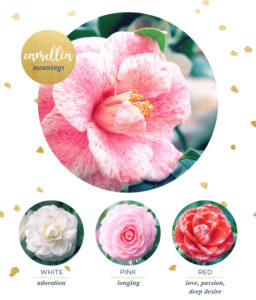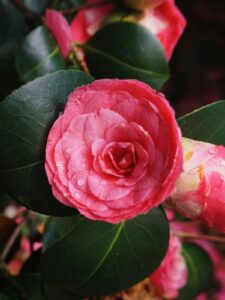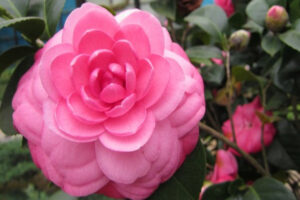Are you a plant enthusiast looking to add some vibrant and unique flowers to your garden? Look no further than the camellia! With over 300 species and a variety of colors and shapes, camellias are sure to add beauty and intrigue to any landscape. Let’s unravel the secrets of this captivating plant together.
What Are Camellias?
Camellias, belonging to the family Theaceae, are flowering plants native to Asia known for their vibrant and beautiful flowers. With various species and varieties, each with its own unique characteristics and bloom times, Camellias are popular choices for gardens and landscaping due to their showy flowers and glossy evergreen leaves. These versatile plants can be grown both indoors and outdoors, making them perfect for decoration. Their blooms come in a range of colors from white and pink to red, adding a touch of elegance to any garden or floral arrangement.
What Are the Different Species of Camellias?
Camellias are a beloved and diverse family of flowering shrubs, with over 200 species and thousands of varieties. In this section, we will take a closer look at the different species of camellias, from the classic Camellia japonica to the lesser-known Camellia sinensis. Each species has unique characteristics and blooming patterns, making them a fascinating subject for gardeners and flower enthusiasts alike. Let’s dive into the world of camellias and discover their beauty and diversity.
1. Camellia japonica
Camellia japonica is a well-known type of camellia that is admired for its stunning flowers. To successfully grow and care for Camellia japonica, simply follow these steps:
- Choose a suitable location that offers partial shade and well-drained soil.
- When planting, make sure the hole is as deep as the root ball and twice as wide.
- Water regularly, ensuring that the soil remains moist but not waterlogged.
- In early spring, fertilize with a slow-release, acid-loving plant fertilizer.
- After the flowering season, prune the plant to maintain its shape and remove any dead or damaged branches.
- Be on the lookout for common pests and diseases such as aphids, scale insects, and root rot.
By following these simple steps, you can successfully cultivate beautiful Camellia japonica plants in your garden.
2. Camellia sasanqua
Camellia sasanqua is a versatile and beautiful species of camellia that is native to Japan. It is known for its small and delicate flowers that bloom in the fall and winter months. These flowers come in various shades, including white, pink, and red.
Camellia sasanqua is a popular choice for landscaping due to its adaptability to different soil conditions and its resistance to pests and diseases. It is also commonly used for hedges and as a foundation plant.
Recently, a friend of mine planted Camellia sasanqua in her backyard and was amazed by its quick growth and blooming. She shared pictures of the stunning flowers on social media and received many compliments. It was a delight for her to see the camellia thrive and add color to her garden during the winter season. She highly recommends Camellia sasanqua to anyone looking for a low-maintenance and visually appealing plant.
3. Camellia reticulata
Camellia reticulata is a stunning species of camellia known for its large, vibrant flowers. It typically blooms during the late winter or early spring and can grow up to heights of 20 feet. These flowers are often bi-colored, with a striking contrast between the inner and outer petals. Some popular cultivars of Camellia reticulata include ‘Captain Rawes’, ‘Silver Waves’, and ‘Elegans’. This species of camellia is highly valued as an ornamental plant in gardens and is frequently used in floral arrangements.
Fun fact: The largest recorded Camellia reticulata flower measured over 9 inches in diameter!
4. Camellia sinensis
Camellia sinensis, also known as the tea plant, is a highly valued species for its role in tea production. Originating from East Asia, it is now grown in various regions around the world. The leaves of this plant are carefully harvested and processed to create a variety of teas, such as black, green, white, and oolong. The unique flavor and characteristics of each type of tea are influenced by factors such as the processing method and the specific cultivar of Camellia sinensis used. With a rich history, this versatile plant continues to be treasured for its significant contribution to the world of tea.
What Are the Popular Varieties of Camellias?
One of the most beloved and beautiful flowering plants, camellias come in a wide variety of species and cultivars. Each with its own unique characteristics and blooming patterns, these varieties of camellias are sure to enchant any garden or landscape. In this section, we will take a closer look at some of the most popular and sought-after camellia varieties, including the vibrant ‘Yuletide’, the delicate ‘Pink Perfection’, the elegant ‘Nuccio’s Pearl’, and the classic ‘Professor Sargent’. Get ready to discover the wonders of these blooming marvels.
1. ‘Yuletide’
The ‘Yuletide’ camellia is a popular variety known for its vibrant red flowers that bloom during the holiday season. To properly care for ‘Yuletide’ camellias, follow these steps:
- Choose the perfect location: Plant in well-draining soil with partial shade.
- Watering and fertilizing: Keep the soil consistently moist, but not waterlogged. It is recommended to fertilize in both spring and summer.
- Pruning: Prune after flowering to maintain the desired shape and remove any dead or damaged branches.
- Pests and diseases: Regularly monitor for pests such as aphids or scale insects, and take appropriate measures to treat them.
For a festive touch, consider pairing ‘Yuletide’ camellias with other holiday plants like holly or poinsettias.
2. ‘Pink Perfection’
Pink Perfection is a highly sought-after variety of camellia, renowned for its gorgeous pink flowers with delicate, ruffled petals. This stunning camellia is a favorite among gardeners and flower enthusiasts, thanks to its vibrant color and graceful appearance. It typically blooms in the winter and early spring, bringing a burst of pink to gardens during the colder months. Pink Perfection is a low-maintenance plant that thrives in well-drained soil and partial shade. Its exceptional beauty makes it a beloved addition to any landscape.
3. ‘Nuccio’s Pearl’
Nuccio’s Pearl is a popular variety of Camellia known for its stunning flowers. To properly care for Nuccio’s Pearl, follow these steps:
- Planting and Location: Choose a well-draining area with partial shade for optimal growth.
- Watering and Fertilizing: Regularly water, ensuring the soil remains moist but not waterlogged. Fertilize with a balanced fertilizer during spring and summer.
- Pruning: After flowering, prune to maintain its shape and remove any dead or damaged branches.
- Pests and Diseases: Keep a lookout for pests such as aphids or fungal diseases. Take necessary measures to treat if needed.
With proper attention and care, Nuccio’s Pearl can flourish and display its gorgeous blooms in your garden.
4. ‘Professor Sargent’
Professor Sargent is a popular variety of camellia known for its stunning flowers and vigorous growth. With large, semi-double to peony-form blooms, it showcases a beautiful blend of pink and white petals. This camellia variety is highly valued for its ability to bloom profusely, adding a burst of color to gardens during the winter and early spring months. ‘Professor Sargent’ camellias are relatively easy to grow and require minimal maintenance, making them a favorite among garden enthusiasts. Whether planted as a focal point or incorporated into a mixed border, this variety of camellia is sure to enhance any outdoor space.
What Makes Camellias Blooming Marvels?
When it comes to breathtaking blooms, camellias are hard to beat. Let’s take a closer look at what makes these flowers true marvels of nature. From their long blooming season to their variety of colors and forms, camellias have captured the hearts of gardeners and flower enthusiasts alike. And the best part? These beauties are easy to grow and require minimal maintenance once established. So, let’s dive into the world of camellias and discover just what makes them such blooming marvels.
1. Long Blooming Season
The extended blooming period is one of the main attractions of camellias for gardeners. To ensure consistent and prolonged blooming, follow these steps:
- Choose the right variety: Select camellia varieties known for their long blooming season, such as ‘Winter’s Interlude’ or ‘April Remembered’.
- Provide proper care: Place camellias in an area with partial shade and well-drained soil.
- Water adequately: Keep the soil consistently moist, especially during the blooming season.
- Fertilize regularly: Apply a balanced, slow-release fertilizer in early spring and mid-summer.
- Prune selectively: Prune after the blooming season to maintain the desired shape and remove any dead or damaged branches.
By following these steps, you can enjoy the beauty of camellias throughout their long blooming season.
2. Variety of Colors and Forms
Camellias are a popular choice among gardeners due to their wide variety of colors and forms. These stunning flowers come in shades of pink, red, white, and even yellow, with different forms including single, semi-double, and peony-like blooms.
For example, the ‘Yuletide’ variety displays vibrant red flowers, while ‘Pink Perfection’ showcases delicate pink petals. ‘Nuccio’s Pearl’ features beautiful white blooms, and ‘Professor Sargent’ offers striking deep red flowers.
By planting a mix of camellia varieties, you can create a visually stunning display in your outdoor space with their diverse colors and forms.
3. Easy to Grow
Camellias are renowned for their ease of growth, making them a popular choice for gardeners of all levels of experience. Here are some steps to successfully grow camellias:
- Choose the ideal location: Camellias thrive in partial shade, well-drained soil, and protection from strong winds.
- Planting: Dig a hole slightly larger than the root ball, place the plant in the hole, and backfill with soil.
- Watering: Maintain consistent moisture in the soil, avoiding waterlogging.
- Fertilizing: Use a balanced fertilizer specifically designed for camellias, following the recommended dosage.
Fun fact: Camellias are native to eastern and southern Asia and were first cultivated in China as early as the 9th century.
4. Low Maintenance
Maintaining camellias is relatively easy due to their low maintenance requirements. Here are some steps to ensure their care:
- Plant camellias in well-draining soil.
- Choose a location with partial shade.
- Water regularly, keeping the soil moist but not waterlogged.
- Fertilize during the growing season with a balanced camellia fertilizer.
- Prune in early spring to remove dead or diseased branches.
- Monitor for pests and diseases, treating them promptly if detected.
With these simple steps, you can enjoy beautiful and thriving camellias in your garden. Remember, maintaining these blooming marvels is a breeze and will keep them healthy and vibrant.
How to Care for Camellias?
Camellias are stunning flowering plants that can add beauty and color to any garden. However, in order to keep them thriving and blooming, proper care is essential. In this section, we will discuss the various aspects of caring for camellias, from planting and location to dealing with pests and diseases. By following these tips, you can ensure that your camellias will flourish and continue to be the marvels that they are.
1. Planting and Location
Planting and choosing the right location for camellias is crucial for their growth and blooming. Here are some steps to consider:
- Choose a suitable location: Camellias prefer partial shade or filtered sunlight. Avoid areas with strong winds or direct afternoon sun.
- Check soil conditions: Camellias thrive in well-drained, slightly acidic soil. Test the soil pH and amend it if necessary.
- Prepare the planting hole: Dig a hole that is wider and slightly shallower than the root ball. Loosen the soil at the bottom of the hole.
- Plant the camellia: Place the camellia in the hole and backfill with soil. Ensure that the root ball is level with or slightly above the ground.
- Water regularly: Keep the soil evenly moist but not waterlogged. Mulching around the plant can help retain moisture.
- Provide some protection: Protect young camellias from frost or extreme cold by covering them or using frost cloths.
2. Watering and Fertilizing
Watering and fertilizing are essential for the proper growth and health of camellias. Here are some steps to follow:
- Watering: Camellias require regular watering, especially during dry periods. It is important to ensure that the soil is consistently moist, but not waterlogged.
- Timing: It is best to water in the morning or late afternoon to allow the foliage to dry before evening, reducing the risk of diseases.
- Amount: Provide 1 inch of water per week, either through rainfall or manual irrigation.
- Fertilizing: Use a balanced slow-release fertilizer specifically formulated for camellias to provide them with the necessary nutrients.
- Frequency: Apply fertilizer once in early spring and again in late summer to support the growth of your camellias.
- Method: Spread the fertilizer evenly around the base of the plant, avoiding contact with the stems or leaves.
By following these watering and fertilizing practices, your camellias will thrive and reward you with beautiful blooms.
3. Pruning
Pruning is an essential task for maintaining the health and appearance of camellias. Here are the steps to follow when pruning camellias:
- Timing: Prune after the blooming season, typically in late winter or early spring.
- Tools: Use clean and sharp pruning shears or loppers.
- Remove dead or diseased branches: Cut them back to healthy wood.
- Shape the plant: Trim branches to maintain a desired shape and size.
- Thin out crowded branches: Remove crossing or overcrowded branches to improve air circulation and sunlight penetration.
- Prune for rejuvenation: Every few years, prune older branches close to the ground to encourage new growth.
- Dispose of pruned branches: Bag and discard any diseased or infested branches to prevent the spread of pests or diseases.
4. Pests and Diseases
Pests and diseases are common challenges when caring for camellias. To protect your plants, follow these steps:
- Inspect regularly: Check your camellias for signs of pests such as aphids, scale insects, or spider mites.
- Natural remedies: Use organic insecticides or soapy water sprays to control pests.
- Proper watering: Avoid overwatering, as it can lead to root rot and fungal diseases.
- Prune infected parts: Remove any affected leaves or branches to prevent the spread of diseases.
- Good air circulation: Trim nearby plants to ensure adequate airflow around your camellias, reducing the risk of fungal diseases.
- Mulch wisely: Apply a layer of organic mulch around the base of the plants to prevent weed growth and maintain soil moisture.
- Remove fallen debris: Regularly clean fallen leaves and other plant debris to prevent disease buildup.
- Consult an expert: If you encounter persistent or severe pest and disease problems, seek advice from a local gardening professional.
Frequently Asked Questions
What are camellias and what makes them unique?
Camellias are flowering shrubs native to Asia that are highly prized for their beautiful blooms and glossy green leaves. They are known for their long blooming season, which typically lasts from fall to spring, and their ability to thrive in both sun and shade.
What are the different species of camellias?
There are over 300 species of camellias, but the most commonly cultivated varieties include Camellia japonica, Camellia sasanqua, and Camellia sinensis. Each species has its own unique characteristics and growing requirements, making them popular among gardeners for their diversity.
How do I choose the right camellia variety for my garden?
When selecting a camellia variety, consider the growing conditions in your garden, such as sunlight and soil type. Some varieties, like Camellia japonica, prefer partial shade and well-drained soil, while others, like Camellia sasanqua, can tolerate full sun and a variety of soil types.
What are the most popular camellia varieties?
Some of the most popular camellia varieties include ‘Nuccio’s Pearl’, known for its large, double white blooms, ‘Pink Perfection’, a classic pink variety, and ‘Kramer’s Supreme’, which boasts large, bright red flowers. Other popular varieties include ‘Debutante’, ‘Yuletide’, and ‘Lady Vansittart’.
How do I care for my camellias to ensure they bloom marvelously?
Camellias require regular watering, especially during their blooming season, and benefit from a layer of mulch to retain moisture. They also benefit from fertilizer applications in the spring and fall. Pruning can help shape the plant and promote more blooms, but be sure to do so after the blooming season.
Can camellias be grown in containers?
Yes, certain varieties of camellias can be grown in containers, making them a great option for those with limited gardening space. When growing camellias in containers, be sure to use a well-draining potting mix and provide regular watering and fertilizer. Pruning may also be necessary to keep the plant at a manageable size.



